
Vice-Admiral William Bligh was a British officer in the Royal Navy and a colonial administrator. He is best known for the mutiny on HMS Bounty, which occurred in 1789 when the ship was under his command. The reasons behind the mutiny continue to be debated. After being set adrift in Bounty's launch by the mutineers, Bligh and those loyal to him stopped for supplies on Tofua, losing a man to natives. Bligh and his men reached Timor alive, after a journey of 3,618 nautical miles.

The First Fleet was a fleet of 11 British ships that took the first British colonists and convicts to Australia. It comprised two Royal Navy vessels, three store ships and six convict transports. On 13 May 1787 the fleet under the command of Captain Arthur Phillip, with over 1,400 people, left from Portsmouth, England and took a journey of over 24,000 kilometres (15,000 mi) and over 250 days to eventually arrive in Botany Bay, New South Wales, where a penal colony would become the first British settlement in Australia from 20 January 1788.

HMS Endeavour was a British Royal Navy research vessel that Lieutenant James Cook commanded to Tahiti, New Zealand and Australia on his first voyage of discovery from 1768 to 1771.

Fletcher Christian was a British sailor who led the mutiny on the Bounty in 1789, during which he seized command of the Royal Navy vessel HMS Bounty from Lieutenant William Bligh.

HMS Pandora was a 24-gun Porcupine-class sixth-rate post ship of the Royal Navy launched in May 1779. The vessel is best known for its role in hunting down the Bounty mutineers in 1790, which remains one of the best-known stories in the history of seafaring. Pandora was partially successful by capturing 14 of the mutineers, but wrecked on the Great Barrier Reef on the return voyage in 1791. HMS Pandora is considered to be one of the most significant shipwrecks in the Southern Hemisphere.

HMAS Australia was one of three Indefatigable-class battlecruisers built for the defence of the British Empire. Ordered by the Australian government in 1909, she was launched in 1911, and commissioned as flagship of the fledgling Royal Australian Navy (RAN) in 1913. Australia was the only capital ship ever to serve in the RAN.
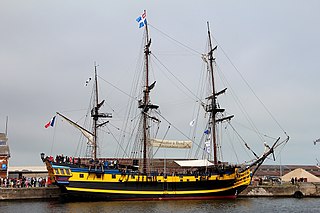
Étoile du Roy, formerly Grand Turk, is a three-masted sixth-rate frigate, designed to represent a generic warship during the Age of Sail, with her design greatly inspired by HMS Blandford. The ship was built in Marmaris, Turkey, in 1996 to provide a replica of a frigate for the production of the ITV series adapted from the novels about Royal Navy officer Horatio Hornblower by C. S. Forester. Nowadays the tall ship is used mainly in sailing events, for corporate or private charter, and for receptions in her spacious saloon or on her deck. In 2010 the French company Étoile Marine Croisières, based at Saint-Malo, Brittany, purchased the ship and renamed her Étoile du Roy.

TSS Kanowna, was an Australian steamer built during 1902. The 6,993-ton, 126-metre (413 ft) long Kanowna was constructed by William Denny and Brothers of Dumbarton, Scotland, and had a twin screw design.

Mutiny on the Bounty is a 1935 Metro-Goldwyn-Mayer drama film directed by Frank Lloyd and starring Charles Laughton and Clark Gable, based on the 1932 Charles Nordhoff and James Norman Hall novel Mutiny on the Bounty. Despite historical inaccuracies, the film was a huge box office success, becoming the highest-grossing film of 1935 and one of MGM's biggest hits of the 1930s. The film received a leading eight nominations at the 8th Academy Awards, winning only Best Picture.

The tallship Søren Larsen is a brigantine built in 1949 in Nykøbing Mors, Denmark. Her current homeport is Sydney, Australia.
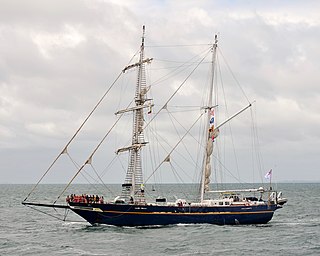
STS Young Endeavour is an Australian tall ship. Built by Brooke Marine, Young Endeavour was given to Australia by the British government in 1988, as a gift to celebrate Australian Bicentenary. Although operated and maintained by the Royal Australian Navy, Young Endeavour delivers up to twenty youth development sail training voyages to young Australians aged 16 – 23 each year. Navy personnel staff the ship and the Young Endeavour Youth Scheme coordinate the voyage program.

R. Tucker Thompson is a gaff-rigged topsail schooner based in Opua, Bay of Islands, New Zealand. She is operated as a non-for profit charitable trust and owned by the R. Tucker Thompson Sail Training Trust. The mission of the trust is “Learning for Life through the Sea”. The ship is used for tourism day sails in the Bay of Islands from October through April and for sail training activities between May and September. Youth sail training is particularly focused at youth from the Tai Tokerau Northland region of New Zealand. She is a member of the Australian Sail Training Association (AUSTA), and participated in the American Sail Training Association (ASTA) West Coast Tall Ships Challenge events in 2002 and 2005.

Tradewind is a Dutch topsail schooner. She was built in the Netherlands in 1911 as a herring lugger named Sophie Theresia.
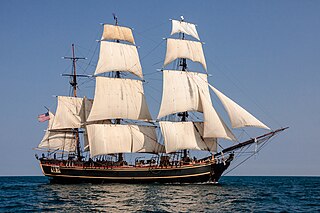
HMS Bounty, also known as HM Armed Vessel Bounty, was a British merchant ship that the Royal Navy purchased in 1787 for a botanical mission. The ship was sent to the South Pacific Ocean under the command of William Bligh to acquire breadfruit plants and transport them to the British West Indies. That mission was never completed owing to a 1789 mutiny led by acting lieutenant Fletcher Christian, an incident now popularly known as the Mutiny on the Bounty. The mutineers later burned Bounty while she was moored at Pitcairn Island in the Southern Pacific Ocean in 1790. An American adventurer helped land several remains of Bounty in 1957.

HMS Endeavour replica is a replica of HMS Endeavour, the bark commanded by Lieutenant James Cook when he charted New Zealand and the eastern coast of Australia.
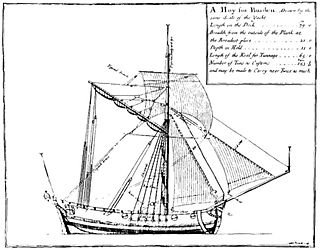
Rose Hill Packet, was a marine craft built in Australia to serve the second place of European settlement in Australia, "Rose Hill", the furthest navigable point inland on the Parramatta River. When launched the vessel was named Prince of Wales but was later named the Rosehill Packet by the convicts. The boat design was later called a packet boat, because its use was that of running the first Parramatta River trade ferry, passenger, cargo, and mail service between the Sydney Cove and the Rose Hill (Parramatta) First Fleet settlements after she was launched in Sydney Cove in September and commissioned on 5 October 1789. She was the first purpose-built sailing vessel constructed in Sydney. She later earned the nickname 'The Lump'. Some authorities believe that a 1790 drawing by First Fleet MIdshipman George Raper shows the vessel in the centre of Sydney Cove.

Southern Swan is a traditional Baltic trader, currently rigged as a three-masted barquentine. She is typical of coastal trading ships from the era 1840s to 1940s.

The First Fleet Reenactment Voyage was a project to assemble a fleet of tall ships to sail from England to Australia in a historical reenactment of the First Fleet that colonised Australia in 1788. The reenactment was first conceived in 1977 and organised to commemorate Australia's bicentenary of colonisation. Despite opposition and minimal funding from the Australian government, the project attracted the support of high-profile adventurers Thor Heyerdahl, Alan Villiers, and Sir Edmund Hillary, as well as former Australian political figures and the British Royal Family. Several corporations offered to sponsor the fleet as a whole or individual ships, and additional money was raised by selling "training crew" berths for the various legs of the voyage.
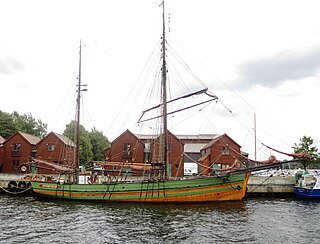
Anna Kristina is a Norwegian-flagged, galeas-rigged Hardangerjakt. Originally named Dyrafjeld, the sloop-rigged vessel was built on a Norwegian farm in 1889. The ship's early career was as a cargo ship in the Hardanger region, with occasional voyages as far afield as Russia. She was sold to new owners and rerigged as a galeas in the late 1920s. The sails were removed during World War II, but continued in merchant service until the mid-1970s. After a series of accidents, the vessel was laid up, then sold to new owners, who restored the vessel and renamed her Anna Kristina. Charter work occurred throughout the 1980s, including involvement in the First Fleet Re-enactment Voyage.
Amorina was built as a lightship in 1934 for the Swedish maritime authorities then designated as lightship 33. It was bought by private parties in 1979, converted to have masts installed and competed in the 1983 Cutty Sark Tall Ships Race.



















